With blue skies dawning and
the Florida sun shining once again, we headed over to the first of two beach
locations in an attempt to track down some of the specialist plovers that make
their home along Florida’s sandy coastline.
Arriving at Bunche Beach to be
met with hundreds of tiny mangrove flies in the car park that insisted on
sticking to our sun cream, we quickly headed to the beach to begin our quest
for American waders. With the tide rapidly coming in, all the birds were extremely
close, meaning we could get excellent views, the only downside being we would
need to be quick before they flew off to their high tide roosts!
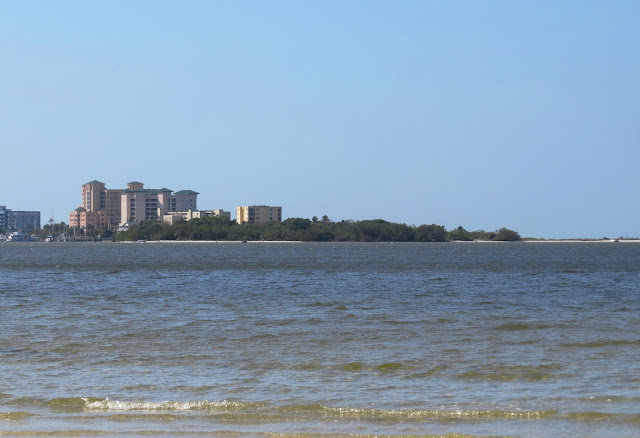 |
| The skyline from Bunche Beach |
Scanning the tideline we
quickly spotted several of our main targets at this site – the extremely ‘cute’
looking Piping Plovers. With their large glassy black eyes, dainty faces and
exceptionally small size, these mini waders scurried along the edge of the
water, several sporting brightly coloured rings on their legs and counting
around 7 individuals in total.
 |
| Piping Plover - complete with leg flags! |
A protected species in Florida
and under threat due to the development of their beach habitat, Piping Plovers
are very much an Eastern American bird in terms of their distribution, so most
definitely a species we needed to connect with. Indeed, these spritely
individuals turned out to be our only ones of the trip!
Scanning the rest of the wader
flock also revealed two Least Sandpipers, miniscule in size and no mistaking
their ID clinching yellowy-green legs. Our only confirmed birds of the trip, we
got great views as they scurried along the lapping waves before being moved on
by the tide.
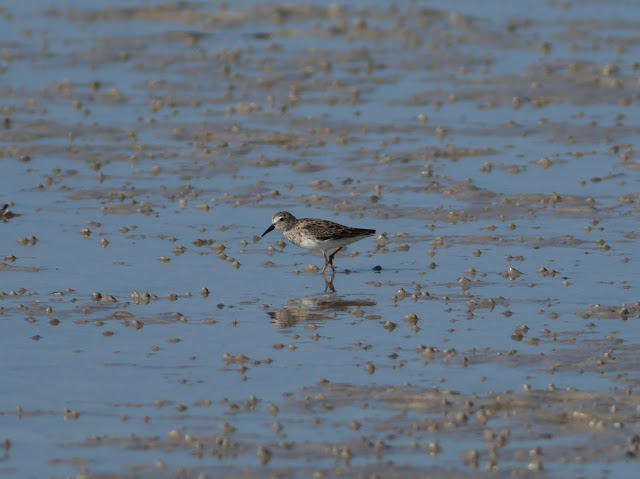 |
| Least Sandpiper |
A single huge Brown Pelican
cruised effortlessly over the waves providing our best photo opportunity yet,
while a pair of Ospreys fished from above, taking advantage of the crystal
clear shallow water.
 |
| Brown Pelican |
 |
| Horseshoe crabs littered the shore |
 |
| Large Sea Sponges also protruded from the sand |
Finding a secluded bay the
tide hadn’t quite reached yet also revealed a confiding flock of Willets,
allowing an extremely close approach and not bothered in the slightest by the
stream of walkers enjoying the truly stunning scenery and white sandy beach
setting alongside them.
 |
| A rather obliging Willet |
With the tide now fully in and
the majority of the waders heading off to their hide tide roost, we headed
south along the seaside towns to our next location and the home of two more
target plovers – Carlos Pointe.
Parking up near Lovers Key and crossing the
huge bridge towering over Big Carlos Pass below, we were soon scanning the vast
white sandy expanses in the search for movement. Spotting several poles and a
roped off area, it was immediately obvious this was a nesting location, and
approaching closer revealed a singly tiny Snowy Plover resting in the sand.
Hunkered down, we were able to get a good look at this beautiful wader, and not
wanting to disrupt and disturb it, we quietly left it in peace.
 |
| Snowy Plover |
Walking along the tideline it
soon became clear that the Snowy Plovers had truly exceptional camouflage
against the white sand – at one point we were mere feet away before we noticed
one pop up off the beach right in front of us – incredible.
It really was a
special experience to have plovers practically walking around your feet –
clearly not perturbed by humans and seeming completely at ease.
It wasn’t long before we had
our third and final plover target of the day safely in the bag – 2 Wilson’s
Plovers, once again their impressive camouflage on point and letting us get to
within feet before hopping up to surprise us. Edging slowly across the sand,
these enormously thick billed waders moved in an incredibly comical fashion,
keeping an eye on us as they shuffled slowly along the beach, settling down
again in the same place and more than likely scoping it out as a potential
nesting spot.
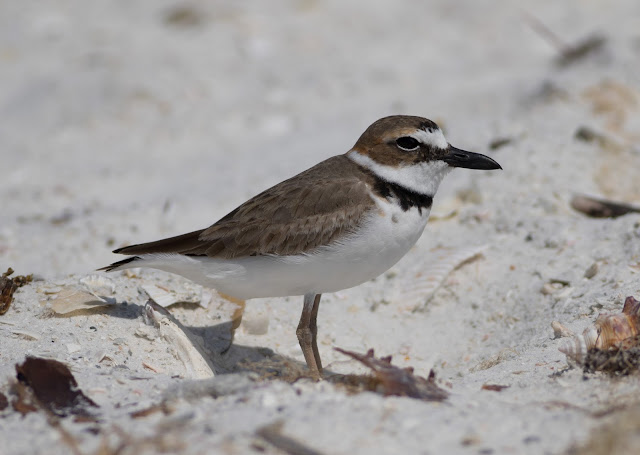 |
| Wilson's Plover |
Like the Piping Plover from
earlier in the morning, Wilson’s Plovers are also predominantly east coast
birds, and it was great to catch up with this unusual looking species.
Taking a wander around the
rest of the beach, we soon caught up with the many terns that had been
screeching noisily over our heads all morning.
 |
| The dainty Least Tern |
A small flock of tiny Least
Terns kept landing in the lapping water, dwarfed by the large breaking waves, with
one individual in particular being not quite quick enough resulting in him
getting repeatedly washed away down the beach by the tide!
A single Royal Tern roosting
on the sand also provided us with point blank views, much more satisfactory
than the distance specs we had on our first day in Florida at Merritt Island.
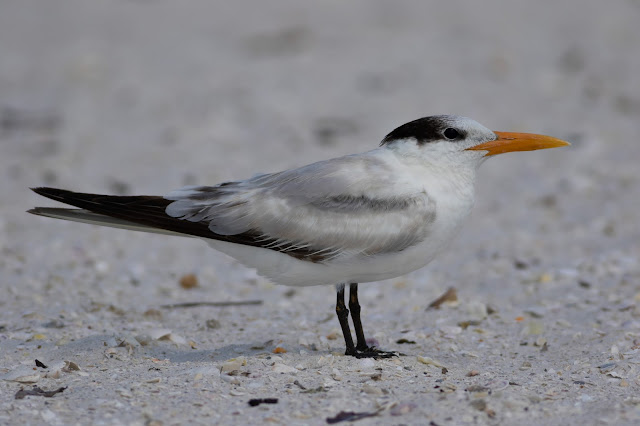 |
| Royal Tern! |
With a much thinner yellower bill in comparison to the thick scarlet red of the
Caspian Terns, it was easy to separate the two and we were able to approach
within metres of this impressive bird.
Achieving close up views of all our
target species, Carlos Pointe seemed like a beach birding wonderland!
 |
| Doing some beachcombing revealed some impressive sea urchins – it was a challenge not to stand on any with our flip flops! |
Having a quick lunch
consisting of melted brunch bars before we departed, we were soon well on our
way to target what was one of my most wanted birds of the whole trip - a male Painted Bunting. Having felt that we
may not connect with a male at Merritt Island (I was right, we’d only seen a
female) I’d done a bit of research before flying out to try and find a nailed
on site for this rainbow patterned wonder.
Noticing a number of records
of males at Felts Audubon Preserve and monitoring the site on e-bird during the
trip, it was clear there was still at least one male hanging around a few days
earlier, and even better, the site was just a 10 minute detour from our hotel
up at St Petersburg.
 |
| Felts Audubon Preserve - home of male Painted Buntings! |
Despite Alex’s protestations
before we flew out about not wasting time on a male if we had already seen
females at Merritt Island, me behind the wheel during this leg of the journey
meant he had little choice but to strap in and enjoy the ride. Arriving at this
secretive and hidden away reserve, we made the short walk to the hide and
feeders the buntings had been coming to, the trees draped in swathes of hanging
moss and lichens creating the impressed of an enchanted wood – the Painted
Bunting clearly the hidden treasure within.
 |
| This Bee Home was just one of many cool things at Felts Audubon Preserve |
Settling down in the hide to
begin our wait, it wasn’t long before the first Indigo Buntings started to
appear, several bright blue males perched on the edge of the clearing, closely
followed by up to 3 female Painted Buntings, all eager to feed on one of the
many large bird feeders surrounding the clearing. It seemed only a matter of
time before our male appeared.
 |
| Indigo Bunting |
At this point however, four
loud photographers entered the hide, and upon swiftly deciding that this set up
didn’t suit their needs, promptly decided to head outside and in to the feeding
compound, right in front of the hide and feeders and completely ignoring the
signs asking birders not to do this. Armed with their huge telescopic lenses
and making a racket of noise, the birds promptly vanished and didn’t reappear
until after they had left (without their shots) half an hour later. Annoyed and
frustrated was an understatement.
 |
| This Cloudless Sulphur offered some distraction whilst waiting for the male Painted Bunting to show. Photo by Alex Jones |
Waiting patiently and quietly
inside the hide, a trickle of birds eventually started to return. With up to 18
Indigo Buntings gradually reappearing, we sat and waited, a wealth of other
regular birds keeping our attention. Northern Cardinals, Blue Jays, Gray
Catbirds and Common Grackles all took advantage of the food scraps on offer,
while a fine Red-bellied Woodpecker put on a show clinging on to the wooden
bird table. A beautiful Swallow-tailed Kite briefly made an appearance, gliding
gracefully over the tree line before vanishing out of sight, while a pair of
Mourning Doves gave us a fright as one powered straight in to the glass of the
hide before taking shelter in the undergrowth – hopefully it was ok!
Then, on the right hand side
of the palm leaves something bright and bold caught my eye. Hopping in to view
and perching on a large leaf, my breath caught in my chest – there in all his
colourful glory was my much sought after male.
 |
| Male! |
With his multi-coloured
feathers displaying every colour of the rainbow, this is surely one of the most
beautiful birds in America – every shade of the palette seemed to shine out of
his wings.
Flitting away before we could
get any photos, we waited until he reappeared – much shyer than the
accompanying Indigo Buntings but eventually putting on a show stopping
performance as he fed on the nearest feeder to us. Definitely a bird I’ll never
forget. Despite not technically being a lifer, this was my second best
individual of the trip, proving that birding should never be about acquiring a
tick – seeing a bird well and at its most beautiful is far more important.
With time marching on, Alex
had his own ‘male’ that he wanted to catch up with. Checking e-bird for any
species we had missed off our checklist before we left, he was stunned to find
a pool containing hundreds of Redheads just 15 minutes away from our hotel in
St Petersburg. Being a wintering species and usually disappearing at the end of
March and beginning of April, this pool in Tierra Verde seemed to contain them
in relatively good numbers right up until the end of April – ideal. Bizarrely
numbers had been much lower this year with birds moving on quicker, and since
the end of March just 1 or 2 individuals lingered on.
Travelling up through St
Petersburg towards the pools the Redheads had been seen on, we had our next
unexpected lifer of the day - a Nanday Parakeet perched on the wires lining the
road. Another introduced exotic, again this species is fully countable under
ABA rules, and we made several brief stops to enjoy these brightly coloured
parrots on the way to the Redheads.
 |
| Nanday Parakeet |
Arriving at the pool it seemed
our luck was in – a single male Redhead swimming swiftly towards us – bingo! A
bird we had no idea would even be present in Florida during our stay just a
matter of weeks ago was now firmly on our list!
 |
| Redhead |
Moving around to the other edge
of the pool to get a better view, another two individuals came out to join our
first male, moving quickly across the pond and allowing us to get some distant
record shots.
 |
| Photobombing Osprey! |
Counting several Red-breasted Mergansers fishing alongside the usual American
Coots and Common Gallinules skulking around the edges of the reeds, the pools
held nothing further of note, and with it now getting late we headed back to
our boutique hotel for the night, stopping to watch several flocks of
chattering Nanday Parakeets along the way.
With a delicious tapas restaurant situated right next door to the hotel, it was safe to say we ate especially well that night, the lamb cutlets in red wine jus a particular favourite and arguably the best food of the trip. Well-fed and extremely satisfied with our birding, we were able to relax for the night before a promising next day at Fort De Soto – with practically all of our targets here already checked off we could afford to step off the gas a little and just enjoy our time leisurely on the beautiful Gulf of Mexico coast.





















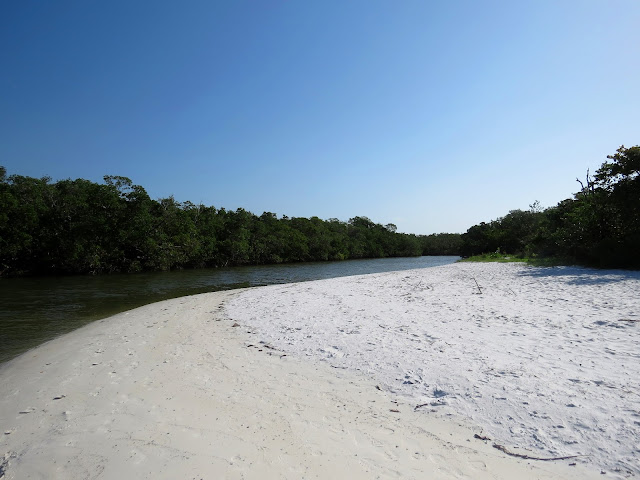




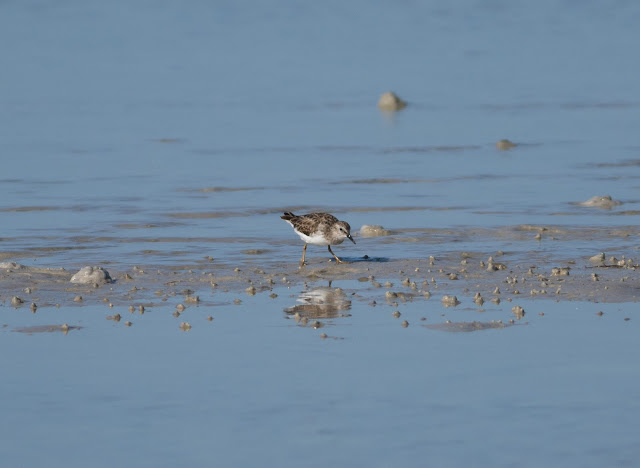











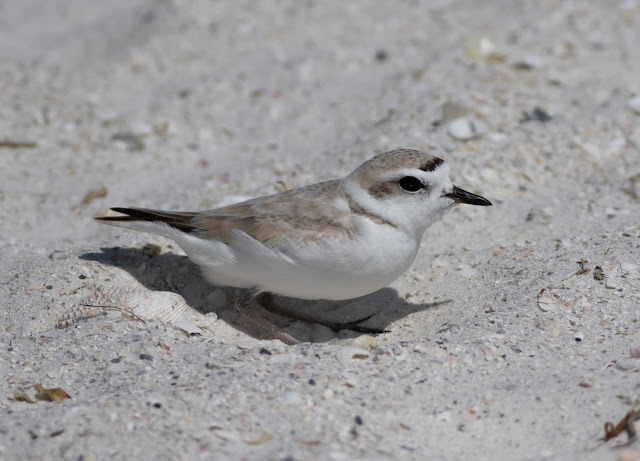














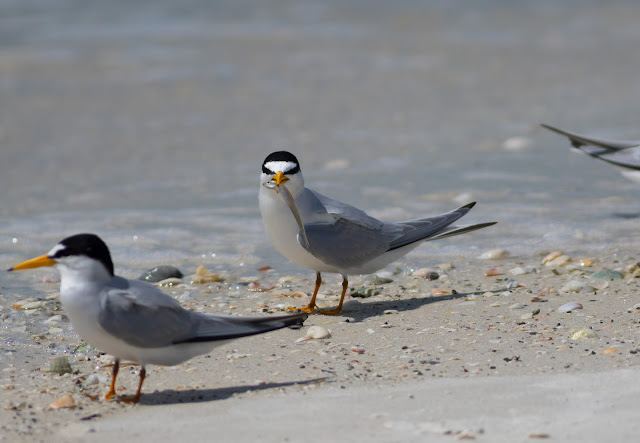


















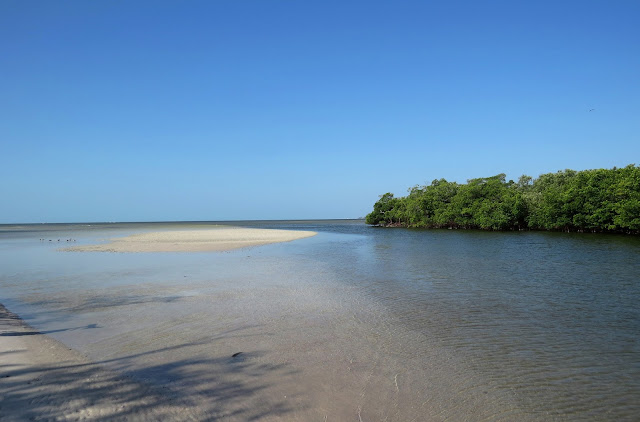
No comments:
Post a Comment